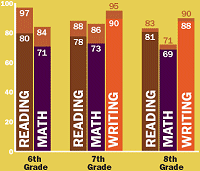Systemic School Reform :: Texas
##AUTHORSPLIT##<--->
IMMERSED IN LEARNING
Texas’ TIP program packages six key technology resources to create a digitally rich environmentthat has helped turn at least one low-performing school into a recognized success.
WHEN SCHOOLS IN TEXAS applied for participationin the Technology Immersion Pilot, they were embarking on a new, exciting journeyin school reform. Technology immersion impacts everystudent, every teacher, every administrator, and every staffmember at a TIP school. With the TIP model, schools implementall six critical technology resources at the same time aspart of a technology immersion “package.”
The six components include a wireless mobile computing device for each student to use at home and school; ongoing professional development for teachers and administrators; online formative and diagnostic assessment tools; online content; productivity tools; and technical support. This way, teachers have the tools they need to assess student proficiency and develop multimedia lesson plans targeted at students’ areas of strength and weakness. Equally important, students are given the same tools as teachers.

TIP-PING POINTS
As a result of its participation in the Texas
Immersion Pilot, Brady Middle School saw
significant gains in student achievement on
the Texas Assessment of Knowledge and
Skills (TAKS) test between 2004 and 2006.
[Percentage of students passing (2004,2006)]
TIP schools began immersion activities in the fall of 2004. Rollout of student laptops began as early as September for some schools and continued through the fall and into early 2005. Many schools scheduled evening events to share details about TIP with parents and the community. Parents attended training sessions along with students and learned about acceptable use policies, and they signed permission slips before their kids were issued laptops.
Reports from TIP schools indicated a shared enthusiasm among students, parents, teachers, and the community. For many families, the program provided their first computer access, as students shared their computer skills with the rest of the household. The program also promoted better communication between parents and teachers, as teachers shared homework assignments, class projects, and samples of student work. (Many TIP websites provide parent access to grades and information about student progress.) Teachers reported increased student motivation; greater collaboration and communication among staff, students, and parents; fewer discipline problems; and more parental involvement and community support.
At the Brady Independent School District, school administrators saw that curriculum alignment was key to leveraging the technology resources that TIP made available to students in this small rural community in central Texas. Teachers began to plan together to ensure they were addressing the specific needs of all their students. Now, three years into the project, Brady students have demonstrated significant achievement increases, both on classroom assignments and on the Texas Assessment of Knowledge and Skills (TAKS) test.

SIX OF ONE
The branches of Texas’ Technology
Immersion Pilot account for every critical
aspect of technology use.
At the onset of the project, Brady Middle School was a “low-performing” campus—as designated by the Texas Education Agency—not satisfying Adequate Yearly Progress. In the spring of 2006, the school boost itself up to a “recognized” campus meeting AYP. Faculty, administrators, and parents attribute the progress to TIP. In key academic areas such as math, reading, writing, and social studies, the percentage of students passing the TAKS has risen across the board since 2004 (see “TIP-ping Points”) The most substantial increases have come in the sixth and seventh grades. For example, the percentage of Brady sixth-graders who passed the reading portion of the 2006 test was up 17 points from 2004, and the number of seventhgraders who passed the math portion rose 13 points.
Brady students were testing below the state average in 2004 and above the state average in 2006. Early results from 2007 indicate the trend continues upward. The students have become more responsible for their learning, more engaged in the classroom, and much more knowledgeable about the role of technology in problem solving and learning.
At Floydada Independent School District in west Texas, local funds made it possible to extend TIP in the fall of 2005 from the district’s junior high to its high school. The expansion produced some dramatic results, particularly at the 10thgrade level, where math and science scores rose 36 and 34 points, respectively, in the first year of the TIP program (see Extracurricular).
Floydada offers a perfect example of how technology-supported systemic reform can throw open the world to formerly closed-off public schools, and that being isolated no longer means being disconnected. This small farming town now has wireless access in every corner, and its students, parents, and community members have become active participants in a global society. The strong leadership of the superintendent, principals, and local board of trustees is credited for bringing technology immersion to the district’s secondary schools, a strategy that will go a long way toward establishing lifelong student learning.
The evaluation of the Texas Technology Immersion Pilot (eTxTIP) websiteis available at www.etxtip.info.
-Anita Givens is senior director of instructionalmaterials and educational technology for theTexas Education Agency